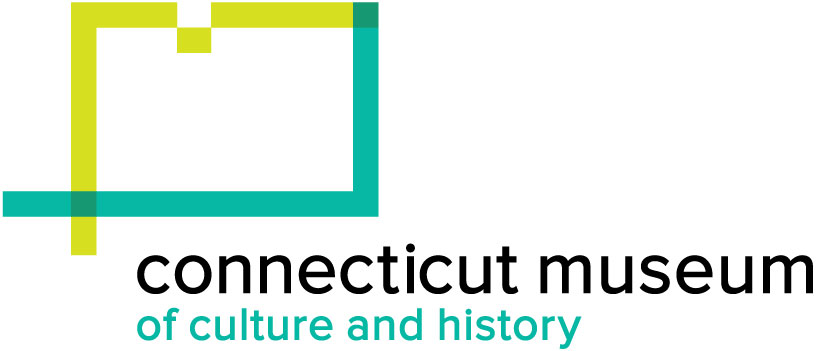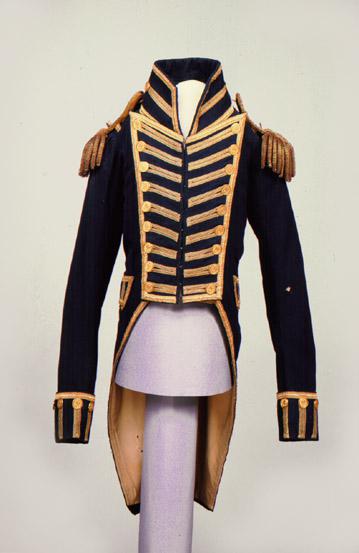Older Boy's or Man's Coat
Clothing MakerMade by
Unknown
Dateabout 1870 with later alterations
MediumDark brown wool fine broadcloth, glazed cotton, satin-woven wool/silk blend, metallic gold twist cord, and gold-over-brass gilt buttons
DimensionsPrimary Dimensions (center back length neck to hem x breast circumference): 30 x 35in. (76.2 x 88.9cm)
Other (sleeve length from shoulder): 23in. (58.4cm)
ClassificationsCostume
Credit LineConnecticut Museum of Culture and History collection
Object number1986.248.0
DescriptionOriginally a single-breasted garment, probably a man's or older boy's frock coat from about 1870. The body of the coat is dark brown wool fine broadcloth, made with fine thread and finely finished. It is faced with tan glazed cotton, lined with a black satin-woven wool/silk blend (typical of the mid-nineteenth century and later), and trimmed on the lapels and cuffs with metallic gold twist cord. The collar is heavily quilted at the rise, and there is a dart on the neck under the lapels. There is quilted lining in the front breast, with a machine-stitched breast pocket on each side, and tail pockets lined with brown glazed cotton set into the skirts. The shape of the sleeves is consistent with the 1870s: wide above the elbow with no elbow points. Other details of the coat making it consistent with mid-century and later are the distinct waist seam and underarm seam, and the side body panels. The coat is machine-stitched in the main body seams and on a piece of folded white cotton sateen that is machine-stitched onto the lapel. The coat has faux lapels; they are only a single layer of cloth that do not fasten across, so they are purely decorative.
The coat was recut in the Colonial Revival style, probably in 1876 for a centennial celebration, making it look like a double-breasted Revolutionary War uniform coat. Tan glazed cotton was applied over the lapels to form revers (turned-back lapels) and turn backs (the turned-back portion of the skirts), to give the appearance of an eighteenth-century military coat. The forepart of the coat from mid-breast to the hem was cut away at an angle to create a historic "cut away" look. Applied lace ruffles were attached to the sleeve lining in layers ---they look like sleeve flounces from a woman's gown. The layers of lace are machine-chain-stitched onto cotton organdy ground.
There appear to be no functional buttons or buttonholes directly visible on the coat in its current state, although the original buttons and buttonholes from the frock coat can still be felt or seen under the lapels and cuffs. A blackened brass hook sewn inside the proper left lapel of the coat catches an elasticized cord loop on the proper right side as a closure. The loop is probably a later addition. The edges of the lapels and cuffs are trimmed in gold twist cord. At waist level on the proper right lapel, this cord forms another loop that may have engaged a gilt United States Army staff officer's button on the proper left side. The button is adorned with the federal eagle with the federal shield on its breast; the shape of the shield and the style of the button itself date it to pre-Civil War era. Alternatively, the staff officer's button may not engage the gold cord loop at all, but rather, the black elasticized loop sewn inside. The coat has undergone such dramatic change that this point is unclear.
There are actually three different types of buttons on this coat. All appear to be about one generation earlier than the rest of the coat. They are all two-piece, gold-over-brass gilt, with a brazed wire shank. The upper button on the proper right cuff is a Connecticut Militia button from the Civil War era. It is back marked "WATERBURY BUTTON CO." The tail vent buttons ar gilt United States Army Infantry officer buttons from about the 1850s or 1860. They are adorned with the federal eagle holding a shield marked with an "I". These buttons are back marked "EXTRA QUALITY". The remaining buttons are gilt pre-Civil War era United States Army staff buttons. They are similar to the infantry button, except that the eagle's shield is an ordinary federal shield, not one marked with an "I". All of these buttons are also back marked "EXTRA QUALITY".
NotesHistorical Note: According to information in the object file, this jacket may be a reproduction of an eighteenth-century jacket.The coat was recut in the Colonial Revival style, probably in 1876 for a centennial celebration, making it look like a double-breasted Revolutionary War uniform coat. Tan glazed cotton was applied over the lapels to form revers (turned-back lapels) and turn backs (the turned-back portion of the skirts), to give the appearance of an eighteenth-century military coat. The forepart of the coat from mid-breast to the hem was cut away at an angle to create a historic "cut away" look. Applied lace ruffles were attached to the sleeve lining in layers ---they look like sleeve flounces from a woman's gown. The layers of lace are machine-chain-stitched onto cotton organdy ground.
There appear to be no functional buttons or buttonholes directly visible on the coat in its current state, although the original buttons and buttonholes from the frock coat can still be felt or seen under the lapels and cuffs. A blackened brass hook sewn inside the proper left lapel of the coat catches an elasticized cord loop on the proper right side as a closure. The loop is probably a later addition. The edges of the lapels and cuffs are trimmed in gold twist cord. At waist level on the proper right lapel, this cord forms another loop that may have engaged a gilt United States Army staff officer's button on the proper left side. The button is adorned with the federal eagle with the federal shield on its breast; the shape of the shield and the style of the button itself date it to pre-Civil War era. Alternatively, the staff officer's button may not engage the gold cord loop at all, but rather, the black elasticized loop sewn inside. The coat has undergone such dramatic change that this point is unclear.
There are actually three different types of buttons on this coat. All appear to be about one generation earlier than the rest of the coat. They are all two-piece, gold-over-brass gilt, with a brazed wire shank. The upper button on the proper right cuff is a Connecticut Militia button from the Civil War era. It is back marked "WATERBURY BUTTON CO." The tail vent buttons ar gilt United States Army Infantry officer buttons from about the 1850s or 1860. They are adorned with the federal eagle holding a shield marked with an "I". These buttons are back marked "EXTRA QUALITY". The remaining buttons are gilt pre-Civil War era United States Army staff buttons. They are similar to the infantry button, except that the eagle's shield is an ordinary federal shield, not one marked with an "I". All of these buttons are also back marked "EXTRA QUALITY".
Status
Not on view

